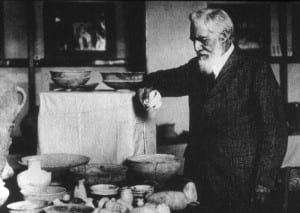 From a public perspective, objects are what a museum is all about. Yet behind every object is a story, built up from a range of sources and evidence, that enables us to contextualise that artefact and give it some form of meaning. This meaning may change as scholarship advances or audiences diversify. But without that level of research, we would have little more than a lot of nice ‘stuff’ on display.
From a public perspective, objects are what a museum is all about. Yet behind every object is a story, built up from a range of sources and evidence, that enables us to contextualise that artefact and give it some form of meaning. This meaning may change as scholarship advances or audiences diversify. But without that level of research, we would have little more than a lot of nice ‘stuff’ on display.
A crucial link in this chain of information comes from archival sources. The Institute of Archaeology is fortunate in having a range of original field records to support its collections, allowing us to learn more about the circumstances in which material was originally excavated. These also provide a window into the methods and practices of seminal figures in the development of archaeology as a discipline. The tomb cards written by Flinders Petrie and his staff are a classic example.
(more…)
 Close
Close




